


To see this report in Portable Document Format (PDF), please
click on the button. ![]() Should
you not have Adobe Acrobat Reader (required to read PDF files),
this free program is available for download at http://www.adobe.com/prodindex/acrobat/readstep.html
Should
you not have Adobe Acrobat Reader (required to read PDF files),
this free program is available for download at http://www.adobe.com/prodindex/acrobat/readstep.html
Open Forum: In an attempt to promote free and open discussion of issues, The Agrichemical and Environmental News encourages letters and articles with differing views. To discuss submission of an article, please contact Dr. Allan Felsot at 509-372-7365 or afelsot@tricity.wsu.edu; or Dr. Catherine Daniels at 509-372-7495 or cdaniels@tricity.wsu.edu. The newsletter is available in a hardcopy version for a $15 yearly subscription fee. Please contact newsletter editor Sally O'Neal Coates at 509-372-7378 or scoates@tricity.wsu.edu for details.
Minor crops are major business. They yielded over $31 billion
in United States sales in 1997, according to the National Agricultural
Statistics Service (NASS). The Washington State Department of
Agriculture (WSDA) reports that Washington's sales for this period
were $5.6 billion, ranking our state 15th in total agricultural
production among all U.S. states and territories. But with respect
to minor crops, Washington is really a major player, ranking second
only to California.
Under the Food Quality Protection Act (FQPA) of 1996, "minor crops" are defined as crops for which fewer than 300,000 acres are devoted for production nationally. Most crops are minor crops.

"Minor use" of a pesticide includes application of a pesticide to a minor crop as well as limited pesticide application to a major crop for a regional pest or localized pest outbreak. The bottom line is economics: use of a pesticide is "minor" when the sales realized on the volume applied on a specific crop/site do not warrant the expense that would be incurred by a registrant to obtain registration for that particular use.
Several factors contribute to the lack of economic incentive for pesticide registrants to register or re-register pesticides on minor crops:
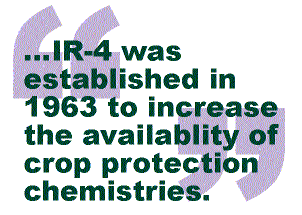 As registrants
shy away from minor use registrations for economic reasons, the
variety of pesticides available for application on minor crops
dwindles. This is referred to as the "minor use problem."
To increase the availability of crop protection chemistries for
minor crop producers, the Interregional Research Project No. 4
(IR-4 Project) was established in 1963. IR-4 is a federal/state/private
cooperative that aspires to obtain clearances for pest control
chemistries on minor crops. Over time, the mandate of IR-4 has
grown to include the encouragement of clearances for less ecologically
disruptive pest controls including bacteria, viruses, fungal and
bacterial extracts, fermentation products, pheromones, and plant
growth regulators. These biological control strategies have become
instrumental in the development and success of Integrated Pest
Management (IPM) systems.
As registrants
shy away from minor use registrations for economic reasons, the
variety of pesticides available for application on minor crops
dwindles. This is referred to as the "minor use problem."
To increase the availability of crop protection chemistries for
minor crop producers, the Interregional Research Project No. 4
(IR-4 Project) was established in 1963. IR-4 is a federal/state/private
cooperative that aspires to obtain clearances for pest control
chemistries on minor crops. Over time, the mandate of IR-4 has
grown to include the encouragement of clearances for less ecologically
disruptive pest controls including bacteria, viruses, fungal and
bacterial extracts, fermentation products, pheromones, and plant
growth regulators. These biological control strategies have become
instrumental in the development and success of Integrated Pest
Management (IPM) systems.
IR-4 prepares and submits petitions to the Environmental Protection Agency (EPA) requesting tolerances or exemptions for pest control products on minor crops. (The IR-4 program does not conduct research on dairy, poultry, livestock, or aquacultural products.)
IR-4 is funded by the United States Department of Agriculture Cooperative State Research, Education and Extension Service (USDA CSREES) and the USDA Agricultural Research Service (USDA-ARS), with substantial additional support from chemical companies and commodity organizations. In 1999, USDA-CSREES provided $8.99 million and USDA-ARS provided $2.1 million in funding. In Washington State, WSU provides support for the State Liaison Representative (me), for a Field Study Director (Ron Wight), for an Analytical Chemist (this position is currently open at Washington State University's Food and Environmental Quality Lab, see notice in this issue), and for our permanent and seasonal support staff.

Anyone can make pesticide needs known to IR-4. Once a project is selected for research, IR-4 will conduct all necessary research and prepare the tolerance petition for review and approval by EPA. The entire process generally takes four to five years to complete.
To initiate the process, an interested party would contact the appropriate state liaison representative (SLR). I am the SLR for Washington. The other Western Region SLRs are listed in the table to the right. The SLR provides the interested party with a Pesticide Clearance Request (PCR) form. The PCR form details the information required by IR-4 to process a request, such as target crop, target pest(s), and pesticide or biopesticide under consideration. Providing as much information as possible and working closely with the SLR can potentially save time in the review process.
Each PCR is reviewed by Regional Coordinators and forwarded with supporting data to IR-4 Headquarters, housed within Rutgers University at the New Jersey Agricultural Experiment Station in New Brunswick (http://aesop.rutgers.edu/~ir4/). IR-4 then determines if required data on product chemistry, toxicology, and environmental fate have already been obtained by the product registrant and whether these data have been accepted by the EPA. If so, IR-4 drafts a letter to the product registrant outlining the proposed use and the data available to support that use. IR-4 offers the registrant the opportunity to conduct the research necessary to obtain a clearance; the registrant must support the process and agree to properly label for the new use. EPA then conducts another review to identify additional data requirements.
 Step
5: IR-4 Workshop and Priority Ranking
Step
5: IR-4 Workshop and Priority RankingFollowing this review process, if IR-4 determines that a project is researchable, it is reviewed at an IR-4 workshop consisting of minor crop experts from across the country. Dr. Bob Parker (WSU Weed Scientist), Lyle Birch (USDA-ARS representative), and I represented Washington State at this year's workshop August 2527 in Denver, Colorado. This annual national workshop consists of three single-day workshops devoted to entomology, plant pathology, and weed science respectively. Each discipline-based workgroup ranks all researchable projects as a high (A or B), medium (C), or low (D) priority project. Other designations include categories 10 and 01, the former being those projects the workgroup agrees should be abandoned, and the latter being those for which all continuing research will be conducted and funded by the registrant (IR-4 will only be responsible for assembling and submitting the petition to EPA).
Under the enthusiastic leadership of IR-4 Director Dr. Bob Holm, A-priority projects are targeted for completion within thirty months. B-priority projects can be worked on if some level of additional support is given by the requesting region, state, commodity organization, or registrant. Category C and D projects basically "sit in the hopper" for now; these projects are deemed researchable, but lack sufficient resources and/or support for completion at this time.
A list of those projects relevant to the Pacific Northwest that were prioritized as A (highest), B (high), or 10 (abandoned) is provided following this article. (Best viewed on pp. 49 of the PDF version of this newsletter.) For the sake of space, items ranked C, D, and 01 were not included.
Following the prioritization workshop, a National Research Planning meeting is held to develop a proposed research program for the following season. First consideration is given to completing ongoing projects. Beyond that, project selection takes into consideration:
The Western Regional Field Coordinators
and federal liaison representatives contract with state, federal,
or private agricultural researchers to conduct the field phase
of the testing program. In this phase, plant safety and performance
data is gathered and crop samples are collected for residue analysis
in the laboratory phase. Laboratories affiliated with IR-4 are
located at state agricultural experiment stations, universities,
and federal analytical facilities.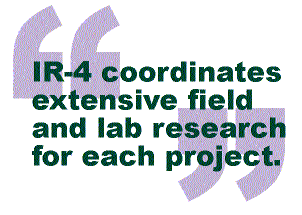
All IR-4 research--field and laboratory--is carried out according to Good Laboratory Practice (GLP) requirements mandated by EPA. This includes a research outline, or protocol, developed by a study director at IR-4 Headquarters. Protocols must be reviewed and approved by commercial registrants. The research protocol includes directions for use based on information supplied by the requestor and agreed upon by the chemical registrant. The research process is inspected by IR-4 quality assurance personnel to validate compliance. The number of field trials required by EPA varies considerably by crop and that crop's production geography. For example, typically sixteen field trials are required to produce adequate samples for magnitude-of-residue studies for apples. Five of these studies must be conducted in either eastern Washington, Oregon, or Idaho. The other nine sites need to be in other apple-producing regions of the United States. For pineapples, usually eight field trials are required, but obviously all the trials must be conducted in Hawaii.
The field samples are then analyzed in the laboratory for residue-level variation. Levels vary between field trials and between various geographic locations. For example, the persistence of a herbicide can vary substantially between geographic regions due to abiotic factors (e.g., weather) and biotic factors (e.g., soil organic matter content).
After the magnitude-of-residue analyses are complete, the study director at IR-4 headquarters assembles all the required data and submits it in the form of a petition to EPA. A positive evaluation by EPA results in publication in the federal register of notice to establish a tolerance.
To date, IR-4 has obtained tolerances for over 300 clearances on more than 100 minor crops in the Pacific Northwest. The IR-4 Project is the main fulcrum for pesticide registration on minor crops in Washington State.
Washington State minor-crop producers and commodity representatives should review the list of crop chemical combinations following. (Best viewed on pp. 49 of the PDF version of this newsletter.) If a project important to you is prioritized as a B, and you wish to work toward elevating that project's status, please contact me directly. We in Washington State have some leverage through commodity group support and additional funding support from the Washington State Commission on Pesticide Registration (WSCPR) to enable projects to be elevated to A priority on the regional level, thereby expediting the completion of research and registration.
Individuals or groups wishing to initiate review of a particular crop-chemistry combination not already ranked or underway can also contact me. I will provide a Pesticide Clearance Request Form as described above. New PCRs will be considered for prioritization and subsequent research in the next review cycle.
For more information on IR-4 in Washington State, contact State Liaison Representative Dr. Doug Walsh at Washington State University's Irrigated Agriculture Research and Extension Center (WSU IAREC) in Prosser: dwalsh@tricity.wsu.edu or (509) 786-2226.
Dr. Walsh commends his colleagues, Bob Parker and Lyle Birch from Washington, Bob McReynolds and Joe De Francesco from Oregon, Ronda Himyck from Idaho, Sandra McDonald from Colorado, Jim Adaska-veg and Harry Agamalian from California, John Palumbo from Arizona, and Margaret Reiff and Ron Hampton from IR-4 Western Regional Headquarters for the level-headed and positive cooperation exhibited in prioritizing projects of regional importance to Western U.S. agriculture at the workshop in Denver.
A=Highest · B=High, requires additional support · 10=Abandoned |
 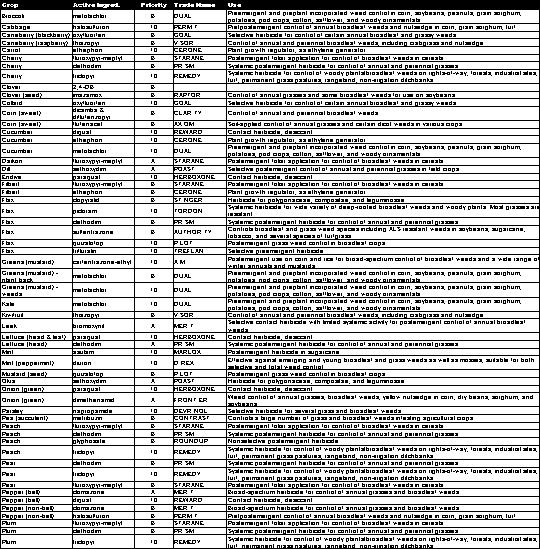 
|
A=Highest · B=High, requires additional support · 10=Abandoned |
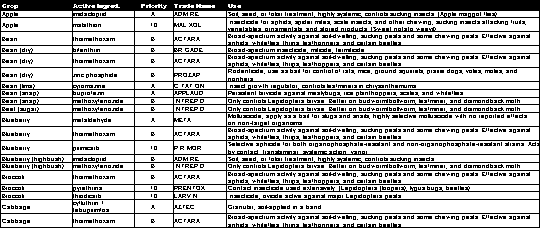 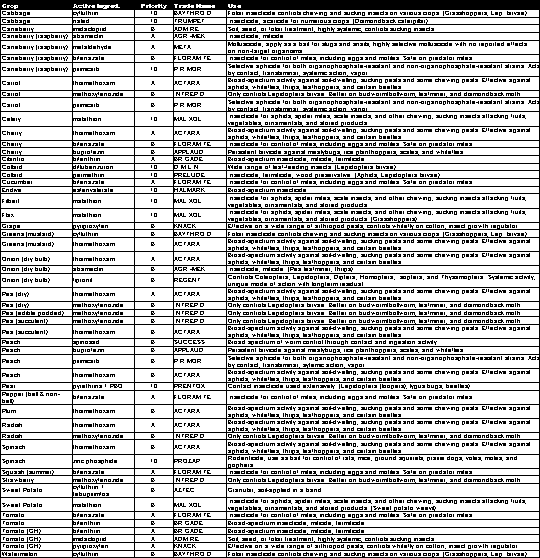
|
A=Highest · B=High, requires additional support · 10=Abandoned |
 
|
|
Global Positioning Systems (GPSs) are becoming increasingly popular tools. These systems use satellites to obtain data that help hikers, boaters, automobile drivers, and others determine location. Now researchers are trying to learn whether GPS technology can assist them in learning more about environmental exposures.
Dr. Beth Mueller, an epidemiologist from the Fred Hutchinson Cancer Research Center and the University of Washington, is working with Sarah J. Ryker, a geographer/water quality specialist with the United States Geological Survey (USGS) in Tacoma, to determine whether GPS can be used along with more traditional research tools to determine exposures to pesticides and nitrates. This study is part of a pilot program funded by the Pacific Northwest Agricultural Safety and Health Center (PNASH) at the University of Washington.
 Health departments
conduct routine surveillance to determine whether levels of contaminants
in drinking water and air are within established public health
standards. Disease surveillance systems have also been established
as part of state and national efforts to monitor the incidence
of various diseases and conditions including cancer and birth
defects. Mueller and Ryker are attempting to determine how such
health data might be linked to geographically specific exposure
data to understand better how exposure might be related to health
and disease.
Health departments
conduct routine surveillance to determine whether levels of contaminants
in drinking water and air are within established public health
standards. Disease surveillance systems have also been established
as part of state and national efforts to monitor the incidence
of various diseases and conditions including cancer and birth
defects. Mueller and Ryker are attempting to determine how such
health data might be linked to geographically specific exposure
data to understand better how exposure might be related to health
and disease.
Pursuant to the overall purpose of linking exposure to health, two specific short-term goals have been established:
For this study, the researchers selected a sample of addresses in rural and urban locations. They then attempted to determine the latitude and longitude coordinates for each test address.
One goal of this project was to determine whether individuals trained as field staff of an epidemiologic study would be able to obtain coordinates for the target addresses. Three researchers were dispatched to obtain the latitude and longitude for each target location with a hand-held GPS unit. They drew maps of their proximity to the target building, they described the local weather features, and they located possible obstacles such as trees, mountains, or tall buildings (such elements have the potential to interfere with the ability of the GPS to connect with the satellites). Based on photographs and descriptions provided by the study geographer, they also attempted to include in their diagram any well housings present near the building.
Ryker entered the latitude and longitude coordinates for the study addresses into a Department of Health Geographic Information Systems (GIS) water-quality information database. The database contains nitrate and pesticide level information for public supply wells in Washington. These data were collected from routine Department of Health tests and from USGS studies.
The geographer developed a program to extract the identity of all public supply wells within a two-mile radius of each coordinate. Since part of the project was to determine the yield of various perimeters around the target location, the program was repeated to locate all wells within a 15-mile radius as well. The next step in the process (currently underway) consists of using a Washington State Department of Health water quality database to determine nitrate levels during the last two decades for each relevant well. Ultimately, these data will be analyzed to answer several questions:
Existing public health data may be an economical component in the evaluation of potential health outcomes from environmental exposures. The extent to which researchers can capitalize on existing geographically referenced databases for large-scale epidemiologic studies, however, depends on the answers to questions such as those addressed in this study. Mueller and Ryker's current work will help to determine how well the existing data and the geographic coordinates answer stated objectives, and to gain an understanding of the linkages between the various data sets. The researchers hope their work will provide the basis for future studies of potentially adverse heath outcomes associated with environmental exposures.
Dr. Mueller can be reached at bmueller@fhcrc.org.
The Pacific Northwest Agricultural Safety and Health Center, funded by NIOSH, is one of nine such centers in the United States. The Center's mandate is to study occupational health and safety issues in farming, forestry and fishing in the four Region X states of Idaho, Washington, Oregon and Alaska. Dr. Richard Fenske is the Center Director, Dr. Matthew Keifer is Co-Director, and Sharon Morris is Associate Director. Adrienne Hidy is the Center's Administrator, and Marcy White is the Program Coordinator.
This article was prepared by Norm Herdrich, PNASH Outreach
Coordinator. To obtain additional information, he can be contacted
at (509) 926-1704, or e-mail him at normh@u.washington.edu.
|
|
|
|
|
|
|
|
|
|
|
|
|
|
|
|
|
|
|
|
|
|
Insomnia can be a drag when it causes
you to surf television channels while lying restlessly in your
bed. But once in a blue moon, a gem sparkles through that glowing
haze like a diamond in the rough. One slumberless night, while
watching the Arts & Entertainment channel, I was surprised
to learn that teenagers in the 1950s were berated for their wildness
and violent ways. The cause? The amorality of the motorcycle culture,
exemplified by participants in the bike clubs popping up all over
the United States. As a college student in the tumultuous late
1960s, I vividly recalled the seeming chaos of love-ins and not-so-peaceful
antiwar demonstrations being blamed on sex, drugs, and rock and
roll.
My thoughts drifted to the tragic news of this year. Headlines
and television were dominated by school shootings and hate crimes.
Parents seem bombarded daily by stories of failing schools and
failing kids. Increasing numbers of our children can't pay attention
because of a syndrome called attention deficit hyperactivity disorder
(ADHD) or some other related brain disorder. Kids are being increasingly
dosed with medication to calm them and help them pay attention.
While the love of motorcycles has not
been invoked to explain the trials and tribulations of today's
troubled teens, just about everything else has. One pundit after
another has dragged out and blamed violent music lyrics and movies,
child abuse, parental neglect, and school's failure to post the
Ten Commandments. Each putative cause has been debated ad nauseum
on the infotainment shows and in newspaper editorials.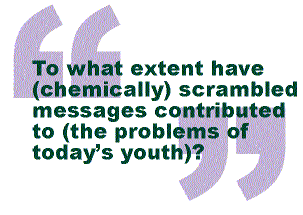
Amidst all the blame, the print media quickly discovered another hypothesis lying dormant within the covers of Theo Colborn's Our Stolen Future (6). Referring to hormonally active agents (HAAs), which are chemicals that can disrupt the endocrine system, Colborn asked, "To what extent have scrambled messages contributed to what we see happening around us--the reproductive problems seen among family and friends, the rash of learning problems showing up in our schools, the disintegration of the family and the neglect and abuse of children, and the increasing violence in our society?"
As I described in a previous AENews essay (Issue No. 139, September 1997), the endocrine system is linked as in a computer network with the immune and nervous systems. Proper growth and development of the fetal brain relies on signals from various hormones, including the sex steroid hormones (estrogen and testosterone) and the thyroid hormones (known as thyroxine, T4, and triiodothyronine, T3) (3). Both types of hormones cross into cells from the blood, move into the nucleus, and then bind to a receptor protein. The protein is essentially linked to the cells' DNA, and when bound by the hormone, eventually causes the synthesis of proteins necessary for cell growth and differentiation of function.
 The fetal brain is
particularly rich in T3 receptors compared to the adult brain.
Thus, like the sex steroid hormones, thyroid hormones play an
important role in neural growth and synapse (junctions between
nerve cells) formation, the synthesis of neurotransmitters (chemicals
transmitting nerve signals across synapses) and their receptors,
and the normal development of behavior and learning abilities.
Any stress, whether nutritional, chemical, or pathological, that
affects the levels of thyroid hormones in the fetus, could potentially
affect normal brain development. For example, a dietary deficiency
of iodine in early development causes hypothyroidism (low production
of thyroid hormone) and leads to a type of mental retardation
known as cretinism (8). Hypothyroidism
can be induced in fetal rats by exposure of mothers to a thyroid
gland toxin called propylthiouracil. The offspring exhibit auditory
and motor function deficits (10).
The fetal brain is
particularly rich in T3 receptors compared to the adult brain.
Thus, like the sex steroid hormones, thyroid hormones play an
important role in neural growth and synapse (junctions between
nerve cells) formation, the synthesis of neurotransmitters (chemicals
transmitting nerve signals across synapses) and their receptors,
and the normal development of behavior and learning abilities.
Any stress, whether nutritional, chemical, or pathological, that
affects the levels of thyroid hormones in the fetus, could potentially
affect normal brain development. For example, a dietary deficiency
of iodine in early development causes hypothyroidism (low production
of thyroid hormone) and leads to a type of mental retardation
known as cretinism (8). Hypothyroidism
can be induced in fetal rats by exposure of mothers to a thyroid
gland toxin called propylthiouracil. The offspring exhibit auditory
and motor function deficits (10).
Processes that rely on thyroid hormones during brain development can be disrupted by several mechanisms (4). Normally, T3 and T4 are carried in the blood by transporter proteins. A T3 or T4 mimic might affect hormone availability to brain cells by attaching to the transporter proteins, thereby blocking binding of the real hormones. A thyroid hormone mimic could enter a cell, bind to the thyroid receptor and thereby either block (antagonize) the action of the natural hormone or turn on (agonize) the receptor. A third possibility is that a hormone mimic might increase the activity of a special enzyme in the liver that reduces the blood level of T4.
Biochemical studies with specific polychlorinated biphenyl compounds (PCBs), DDT and its metabolites, and the herbicides alachlor and acetochlor showed no binding to thyroid receptors nor transporter proteins. However, metabolites of PCBs called hydroxylated PCBs (PCB-OH) that are found in blood were capable of binding the receptor (4). Metabolites of PCBs called methylsulfone-PCBs that are found in breast milk have been shown to reduce thyroid hormone levels in rats (13). Feeding maternal rats commercial mixtures of PCBs known as Arochlors reduces thyroid hormone levels in fetal rat brain (17) and blood (11). Infant rats born to Arochlor-exposed mothers suffer hearing and behavioral deficits (11).
Studies with rodents rely on feeding very high levels of PCBs. For example, behavioral and auditory deficits were observed when pregnant rats were fed 4 or 8 milligrams of Arochlor per kilogram of body weight per day (mg/kg/d) but not 1 mg/kg/d (11). Average human exposure to PCBs in food, air, and water has been estimated to total 0.3 mg/year (7). Assuming a woman weighed 60 kg, the average total PCB intake would only be 0.000014 mg/kg/d!
 Human PCB intake seems
too miniscule to cause any effects on a developing fetus. Nevertheless,
on several occasions children have been exposed to extraordinarily
high levels of PCBs. In Japan during 1968 and Taiwan during 1979,
rice contaminated by PCB-laced cooking oil caused notable symptoms
in over a thousand people (21).
Babies born to exposed mothers in Taiwan were monitored for adverse
health effects through age 10 (5).
Exposed children exhibited greater tendency for emotional or behavioral
disorders and slightly more hyperactivity compared to unexposed
children. The estimated average intake of PCBs over an eight-month
period was 1 gram (12). Thus, we could
estimate a female weighing 60 kg to have been exposed to a dose
of PCBs in contaminated cooking oil equivalent to 0.07 mg/kg/d.
This exposure was lower than levels known to cause effects in
rats, but dioxin-like compounds with endocrine disrupting effects
had also formed during cooking.
Human PCB intake seems
too miniscule to cause any effects on a developing fetus. Nevertheless,
on several occasions children have been exposed to extraordinarily
high levels of PCBs. In Japan during 1968 and Taiwan during 1979,
rice contaminated by PCB-laced cooking oil caused notable symptoms
in over a thousand people (21).
Babies born to exposed mothers in Taiwan were monitored for adverse
health effects through age 10 (5).
Exposed children exhibited greater tendency for emotional or behavioral
disorders and slightly more hyperactivity compared to unexposed
children. The estimated average intake of PCBs over an eight-month
period was 1 gram (12). Thus, we could
estimate a female weighing 60 kg to have been exposed to a dose
of PCBs in contaminated cooking oil equivalent to 0.07 mg/kg/d.
This exposure was lower than levels known to cause effects in
rats, but dioxin-like compounds with endocrine disrupting effects
had also formed during cooking.
Fish are the source of most PCBs in the average human diet (7). A group of children born to women eating large amounts of fish from the Great Lakes has been monitored for over eleven years. Children with the highest levels of prenatal (i.e., fetal) exposure to PCBs were three times as likely as children with the least exposure to have lower average IQ scores (a difference of 6.2 IQ points), and twice as likely to be at least two years behind in reading comprehension (15). The results mimicked behavioral deficits measured in the exposed group at earlier ages (14), but pertinently, a clear threshold in PCB exposure was observed. To wit, no effects were observed unless mother's milk had greater than 1.25 ppm of PCBs. Thus, similar to the rat studies, effects were related to dose.
Infant PCB exposure is greatest through breast-milk feeding. Yet a review of all studies attempting to link PCB exposure in food to behavioral deficits in children paradoxically reveals that only exposure during pregnancy could be associated with an effect (18). Thus, the good news is that breastfeeding did not influence the cognitive and behavioral scores. The data also show the importance of reducing chemical exposures during pregnancy.
Few pesticides have been examined for
their effect on children's cognitive and behavioral development.
The National Academy of Sciences (18) concluded that DDT, which is stored in body
fat and breast milk, did not seem to have any adverse effects
on young children. Nevertheless, the Food Quality Protection Act
(FQPA) reflects public concern that pesticides may be harming
children more than adults. This concern was raised a notch this
spring by the headline "Study Links Pesticides to Brain Damage
in Kids" (16). This alarming
headline was generated by a press release from the University
of Wisconsin concerning a study published in the journal Toxicology
and Industrial Health by one of its faculty members (19, hereinafter referred to as the TIH study).
The study purportedly found that endocrine, immune, and behavior
changes occurred in mice exposed via drinking water to low doses
of mixtures of an insecticide (aldicarb), herbicide (atrazine),
and nitrate. The study was hailed as a significant breakthrough
proving the cumulative effect of low doses of agrochemicals in
mixtures.
Given the fast-paced nature of newspaper reporting, no one expects journalists to scrutinize scientific reports with the same zeal they use to dissect a politician's life. Given the importance of the TIH study's conclusions, however, it should be judged on its own merits rather than interpreted through newspaper accounts.
The TIH study's experimental design was quite comprehensive in attempting to study all possible combinations of aldicarb, atrazine, and nitrate mixtures. Contrary to how the dosing was presented in the media, the concentrations tested were not characteristic of groundwater contamination, nor were they at the regulatory maximum contaminant levels. In fact, the concentrations in water were 10 parts per billion for aldicarb and atrazine, and 28 parts per million for nitrate-nitrogen. While these are some of the lowest doses ever tested, such levels are unrealistically high according to the United States Geological Survey (USGS) National Water Quality Assessment (NAWQA) database (http://water.wr.usgs.gov/pnsp/allsum/#gw). This fact alone should not detract from the TIH study, however, because most toxicological testing is done at excessively high dosing levels.
The TIH study measured numerous toxicological
endpoints including body weight, spleen weight, thyroid hormone
levels, plaque cell formation (immune system effect), and aggressive
behavior in male mice. Each test was repeated up to nine times
over a five year period and then subjected to a statistical analysis
to determine whether the results were due to the chemical exposures
or to random chance.
In laboratory studies, an analysis of variance is the accepted
statistical test for determining the probability that a toxicological
parameter measured in a population of animals is due to the chemical
exposure as opposed to random chance. In other words, the experimenter
tests a hypothesis that some chemical either causes no adverse
effect (known as the null hypothesis) or that it does cause an
effect. For each test, multiple animals are exposed to a given
dose of chemical. Individual animals will differ in their responses,
but distribution of responses (variance) and the average response
for any exposure can be calculated. Using the variation in responses,
the experimenter will then calculate the probability that the
measured response to chemical exposure did not occur by chance
alone. Any measurement in controlled laboratory experiments having
less than a 5% probability of occurring by random chance is considered
statistically significant. In this case, the experimenter would
reject the null hypothesis (the chemicals had no effect) and conclude
that exposure caused a significant adverse response.
For each individual experiment, the TIH
study tabulated the probability that the measured effects were
not due to chance variations alone. When the probability was less
than 5%, the study concluded that exposure to the contaminated
water caused the responses measured. With few exceptions, no significant
difference in responses between dosed animals and controls (animals
not exposed) resulted when single chemicals were mixed in water.
In other words, of the twenty-seven possible single chemical exposure
experiments, almost none met the test for statistical significance.
Amazingly, the statistical analyses for all possible combinations of mixtures also showed very few significant differences (Table 1). For example, in nine separate experiments where thyroid hormone level was measured, only one test with mixtures was statistically significant. In fact, most of the studies couldn't even meet the test for significance at a probability level of 20% or greater, yet alone 5%. The inconsistent and random nature of the results is further illustrated by close examination of the plaque-forming cell assay results. One out of eight experiments showed statistical significance when exposure was to aldicarb or atrazine alone. Three or fewer were significant with each possible binary mixture. Paradoxically, no significant effects were observed at all when exposure to all three was tested.
The overwhelming lack of statistically
significant differences in the TIH study should have led to a
conclusion that the measured effects of single and multiple chemical
exposures were at best inconclusive. Nevertheless, the study's
lead author was quoted in the Los Angeles Times as saying "Data
suggest that we may be raising a generation of children with learning
disabilities and hyper-aggression."
The statement made to the press echoes the hypothesis propounded in Our Stolen Future (6). Such a broad hypothesis is unlikely to be ever proven true or false. However, insights about the validity of the hypothesis can be gleaned by looking at trends. While the media screams about declining test scores and violent behavior among U.S. youth, recent statistical trends reveal a different picture. IQ scores have been going up in industrialized countries since the 1940s (2). Crime, which is overwhelmingly committed by males under twenty-four years of age, has declined for the seventh straight year (9). New evidence suggests that ADHD may be overdiagnosed because it cannot be tested by physical means and its diagnosis essentially boils down to an "educated guess" (1).
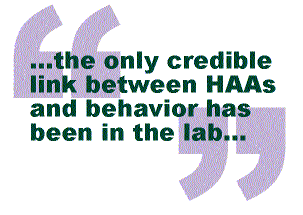 Thus far, only laboratory
experiments with PCB have made a credible link between HAAs and
behavior. The mechanism seems to involve alterations in thyroid
hormone levels in fetal rats. Studies of extraordinarily high
levels of human exposure to PCBs seem provocative, but they do
not support a conclusion that average dietary levels of PCBs have
had measurable adverse effects. No credible study has linked neonatal
or infant exposure of environmental levels of pesticide residues
to mental deficits in rats. Nor do global trends in intelligence
measurements support the hypothesis that HAAs are affecting human
mental abilities.
Thus far, only laboratory
experiments with PCB have made a credible link between HAAs and
behavior. The mechanism seems to involve alterations in thyroid
hormone levels in fetal rats. Studies of extraordinarily high
levels of human exposure to PCBs seem provocative, but they do
not support a conclusion that average dietary levels of PCBs have
had measurable adverse effects. No credible study has linked neonatal
or infant exposure of environmental levels of pesticide residues
to mental deficits in rats. Nor do global trends in intelligence
measurements support the hypothesis that HAAs are affecting human
mental abilities.
PCBs were first commercialized in 1929, long before we could measure them; indeed, before water quality was regulated. By the 1950s, anyone living in an urban area would have been exposed to PCBs. PCBs were finally banned in the late 1970s. Since that time, the amounts stored in our body fat have been steadily declining along with the levels of banned pesticides like DDT (20).
After a night of thinking about kids' behavior, I finally did fall peacefully asleep. My optimism about the future inspired me to give my kid a big hug in the morning. I know he is a lot smarter than I am, but I'm still not going to buy him a motorcycle any time soon.
Dr. Allan Felsot is an Environmental Toxicologist with Washington State University. He can be reached at afelsot@tricity.wsu.edu or (509) 372-7365.
Purdue University Cooperative Extension Service has produced a
112-page handbook, Pesticides and Planning for Emergencies: Prevention,
Reaction, and Response, designed for commercial industries such
as lawn services, golf courses, aerial applicators, and commercial
agriculture enterprises. See it on-line at
or order a copy ($30) from the Media Distribution Center at
(888) 398-4636, Media.Order@ces.purdue.edu;
or Purdue University, Agriculture Communication Services, Media
Distribution Center, 301 S. 2nd Street, Lafayette, IN 47901-1232.The
full-color publication offers advice, instruction, and recommendations
on anticipating emergencies, evaluating your worksite, and responding
to emergent situations. Included are do-it-yourself worksheets
and checklists for hazard assessment, monthly inspections (fire
extinguishers, exit signs, first aid kits), chemical inventory,
and emergency telephone contacts. Companion piece PPP-45, Quick
Response Emergency Plan, (not available on the Internet) can be
ordered for $5.
|
|
|
|
|
|
|
|
|
|
Washington State University offers PRE-LICENSE courses (for those who do not have a license and need one) and RECERTIFICATION courses (for those who need to renew their current licenses). Fees are $35 per day if postmarked 14 days before the program, otherwise $50 per day. This fee DOES NOT include WSDA license test fee, which ranges from $25 to $170; for information on testing and fees, contact WSDA at (360) 902-2020 or http://www.wa.gov/agr/test/pmd/licensing/index.htm. Recertification courses offer 6 credits per day.
|
Dear Aggie
In news from Europe, I've noted a lot of opposition to genetically engineered crops that have pesticide genes in them. I know that the gene for the toxic protein from the microbial insecticide Bacillus thuringiensis (Bt) has been cloned into corn and potatoes. While people in Europe seemed concerned about potential hazards of this genetically engineered pesticidal protein, I don't sense there is any concern about the Bt sprays, even though the sprays contain the same protein. Bt spray is a certified organic pesticide, so it must be safe to humans, right?
Signed,
Microbially Confused
Dear Microbially Confused,
The Europeans do seem hot and bothered about genetically engineered crops. Aggie can't figure out if they are going through some ethical and moral epiphany about genetic tinkering or if they are really worried about health hazards.
Until recently, Aggie pooh-poohed worrying about Bt products, sprayed or engineered. But a double whammy of new reports indicate that Bt, a bacterium naturally found nearly everywhere in the environment, may be meaner than we think.
Bt spray generally has an excellent safety record with minor exceptions. Large-scale spraying of Bt for control of Asian Gypsy Moth, a pest in forests in the Northwest during the early 1990s, engendered complaints of rash and swelling, nasal inflammation, and exacerbation of asthma. A team of scientists from the University of Cincinnati College of Medicine and the EPA recently reported results from studies of farm workers' immune response to Bt. Farm workers who picked vegetables sprayed multiple times with Bt were monitored and compared to workers of low or no exposure. Workers were tested for exposure to Bt, hypersensitivity to Bt extracts, and production of specific antibodies (known as IgE and IgG) against Bt. The good news was a lack of occupationally related respiratory symptoms among the workers. The bad news was evidence of a greater prevalence of hypersensitivity to Bt among the most highly exposed workers. The researchers concluded, "Exposure to Bt sprays may lead to allergic skin sensitization and induction of IgE and IgG antibodies, or both."
Another report indicated that certain strains of Bt may be outright toxic, not just allergenic. Effective Bt products may be any one of several strains that produce an insecticidal toxin. The Bt spores are used in the insecticidal spray. French scientists have isolated a strain of Bt known as H34 that can kill healthy mice that inhale as few as 108 spores. The mice developed internal bleeding and tissue damage. Mutant Bt spores that don't produce the insecticidal toxin were equally lethal, suggesting that the insecticidal toxin is irrelevant to the adverse effect. A close cousin of Bt, Bacillus cereus, produces another type of toxin that ruptures cell membranes. Japanese scientists have shown that at least one Bt strain can produce that same toxin. Bt H34 is not used as an insecticide, but the French researchers reported that some commercial Bt strains also killed mice or caused lung inflammation after the spores were inhaled. A spokesperson representing British organic farmers said that they may have to use masks and take more care when spraying the spores on crops. Ironically, to be certified as an organic pesticide, a substance must not be cytotoxic.
In the innocence of a few months ago, organic farmers' worst complaint about Bt might have been a concern that resistant pests would develop more rapidly with the proliferation of their favorite insecticide in both sprayed-on and cloned-in forms. These recent studies might give them something else to ponder. While Aggie doesn't see organic growers clamoring to remove Bt from their safe list any time soon, the Bt stories do remind one that there is no free lunch.
(Sources: Bernstein et al., 1999, Environmental
Health Perspectives, vol. 107, pp. 575-582; New Scientist, May
29, 1999)
Washington Pest Consultants Association organizes an annual series of collection dates and sites for empty pesticide containers. Dates and locations are subject to change; confirm with a telephone call to the number listed in the table before participating. For general questions, or if you are interested in hosting an event at your farm, business, or in a central location in your area, contact Clarke Brown at (509) 965-6809 or Roger Ours at (509) 930-6950.
DATE |
TIME |
LOCATION |
CONTACT |
PHONE# |
OTHER |
|
|||||
| 10/13 | 8 am to 3 pm | Othello Airport | Mark Conner | 509-488-2921 | |
| 10/14 | 8 am to 10 am | Western Farm Service, Waterville | John Massey | 509-838-5007 | |
| 12 pm to 2 pm | Western Farm Service,Coulee City | 509-838-5007 | |||
| 3 pm to Finish | The Crop Duster, Ephrata | Martin Shaw | 509-754-3461 | ||
| 10/18 | 8 am to 11 am | Wilbur Airport | Greg Leyva | 509-647-2441 | |
| Dennis Buddrius | 509-647-5394 | ||||
| 1 pm to 4 pm | Davenport Airport | Lee Swain | 509-725-0011 | ||
| 10/19 | 8 am to 12 pm | Western Farm Service, Rosalia | John Massey | 509-838-5007 | |
| 1 pm to 3 pm | McGregor's Colfax | Joel Fields | 509-397-4691 | ||
| 10/20 | 8 am to 10 am | B & R Aerial Crop Care, Connell | Chris Eskildsen | 509-234-7791 | |
| 12 pm to 3 pm | Air Trac, Pasco | Gerald Titus | 509-547-5301 | ||
| 10/25 | 9 am to 3 pm | Snipes Mtn, Transfer Station | Mark Nedrow | 509-574-2472 | Cardboard Accepted |
| 10/26 | 8:30 am to 3 pm | Terrace Hts. Landfill, Yakima | Mark Nedrow | 509-574-2472 | Cardboard Accepted |
| 10/27 | 1 p.m. to 4 p.m. | Kilmer Crop Dusting, Warden | Terry Kilmer | 509-349-2491 | |
| 10/28 | 9 am to Noon | Tom Dent Aviation, Moses Lake | Tom Dent | 509-765-6926 | |
In reviewing the August postings in the Federal Register, we found the following items that may be of interest to the readers of Agrichemical and Environmental News.
In the August 4 Federal Register, EPA announced that two draft science policy papers were available for comment. The documents, "Guidance for the Conduct of Bridging Studies for Use in Acute Dietary Probabilistic Risk Assessments'' and "Guidance for the Conduct of Residue Decline Studies for Use in Acute Dietary Probabilistic Risk Assessments,'' will be available on the web at URL: http://www.epa.gov/pesticides/trac/science/. (Page 42372)
In the August 6 Federal Register, EPA announced the availability of and requested comments on a Pesticide Registration Notice that presents EPA's proposed approach for managing risks from organophosphate pesticides to occupational users. The notice is available on EPA's OPP page (http://www.epa.gov/pesticides/) under the August 6th information. (Page 42943)
In the August 13 Federal Register, EPA announced the availability of the revised risk assessments and related documents for methyl parathion. These documents are available for review on the following URL: http://www.epa.gov/pesticides/op/methyl_parathion.htm. (Page 44219)
In the August 18 Federal Register, EPA announced the availability of the revised risk assessments and related documents for chlorethoxyfos. These documents are available for review on the following URL: http://www.epa.gov/pesticides/op/chlorethoxyfos.htm. (Page 44921)
The PNN is operated by WSU's Pesticide Information Center for
the Washington State Commission on Pesticide Registration. The
system is designed to distribute pesticide registration and label
change information to groups representing Washington's pesticide
users. PNN notifications are now available on our web page. To
review those sent out in August either access the PNN page via
the Pesticide Information
Center On-Line (PICOL) Main Page on URL http://picol.cahe.wsu.edu/
or directly via URL http://www.tricity.wsu.edu/~mantone/pl-newpnn.html.
We hope that this new
electronic format will be useful. Please let us know what you
think by submitting comments via e-mail to Jane Thomas at jmthomas@tricity.wsu.edu.
| Chemical (type) | Federal Register | Tolerance (ppm) | Commodity (raw) |
|
||
| Yes/No | New/Extension | Exp. Date | ||||
| imidacloprid (insecticide) | 8/2/99 page 41804 | 3.5 | watercress (upland) | No | N/A | N/A |
| 0.5 | cucurbit vegetables (Crop Group 9) | |||||
| 0.3 | tuberous and corm vegetable subgroup | |||||
| propiconazole (fungicide) | 8/2/99 page 41812 | 0.2 | grain sorghum, grain | Yes | Extension | 7/31/00 |
| 1.5 | grain sorghum, stover | 7/31/00 | ||||
| 20 | sorghum grain aspirated fractions | 7/31/00 | ||||
| 0.5 | dry bean | 12/31/00 | ||||
| 8 | dry bean forage | 12/31/00 | ||||
| 8 | dry bean hay | 12/31/00 | ||||
| Comment: This action re-establishes time-limited tolerances that expired 7/31/98 or 12/31/98. | ||||||
| pyriproxyfen (insecticide) | 8/2/99 page 41810 | 0.1 | tomatoes | Yes | Extension | 12/31/01 |
| Comment: This time-limited tolerance is being extended in response to a request received by EPA to extend the use of pyriproxyfen on tomatoes for this year's growing season due to the continuing emergency situation with whiteflies in southern areas of the U.S. | ||||||
| azoxystrobin (fungicide) | 8/4/99 page 42280 | 20 | parsley, dried | Yes | New | 12/30/00 |
| 100 | parsley, fresh | |||||
| Comment: These time-limited tolerances are being established in response to EPA granting a Section 18 for the use of azoxystrobin to control Septoria leaf blight in California parsley. | ||||||
| flufenacet/fluthiamide (herbicide) | 8/6/99 page 42869 | 1 | wheat grain | Yes | New | 7/31/01 |
| 10 | wheat forage | |||||
| 2 | wheat hay | |||||
| 0.5 | wheat straw | |||||
| 0.05 | meat and fat of cattle, goats, horses, hogs, and sheep | |||||
| 0.5 | kidney of cattle, goats, horses, hogs, and sheep | |||||
| 0.1 | mbp of cattle, goats, horses, hogs, and sheep | |||||
| Comment: These time-limited tolerances are being established in response to EPA granting Section 18s for the use of this chemical to control ryegrass in Oregon, Washington, and Idaho wheat. | ||||||
| pyriproxyfen (insecticide) | 8/18/99 page 44826 | 0.2 | pears | Yes | Extension | 1/31/01 |
| Comment: This time-limited tolerance is being re-established in response to EPA again granting Section 18's for the use of pyriproxyfen on citrus fruit and pears. | ||||||
| glufosinate-ammonium (herbicide) | 8/18/99 page 44829 | 1.1 | canola meal | Yes | New | 12/1/99 |
| 0.4 | canola seed | |||||
| 4 | sweet corn forage | |||||
| 4 | sweet corn kernels and cobs (husks removed) | |||||
| 6 | sweet corn stover | |||||
| Comment: These time-limited tolerances are being established in response to EPA granting Section 18's for the use of glufosinate-ammonium on sweet corn and canola. | ||||||
| buprofezin (insecticide) | 8/23/99 page 45885 | 0.7 | tomato | Yes | Extension | 12/31/01 |
| 1 | tomato paste | |||||
| 0.03 | milk | |||||
| 0.02 | meat and fat of cattle, goats, horses, hogs, and sheep | |||||
| 0.5 | mbp of cattle, goats, horses, hogs, and sheep | |||||
| Comment: These time-limited tolerances are being extended in response to EPA again granting Section 18's for the use of buprofezin on tomatoes, citrus, and cotton. | ||||||
| desmedipham (herbicide) | 8/25/99 page 46290 | 0.2 | red beet roots | Yes | Extension | 12/31/00 |
| 15 | red beet tops | |||||
| Comment: These time-limited tolerances are being extended in response to EPA again granting a Section 18's for the use of desmedipham on garden beets grown in New York. | ||||||
| pyridate (herbicide) | 8/25/99 page 46292 | 0.3 | peppermint tops | Yes | New | 12/31/01 |
| 0.3 | spearmint tops | |||||
| Comment: These time-limited tolerances are being established in response to EPA granting Section 18's for the use of pyridate on mint in several states. | ||||||
W.S.U. Pullman Home Page Comments and questions: cdaniels@tricity.wsu.edu Technical Assistance: scoates@tricity.wsu.edu Copyright © Washington State University / Disclaimer Electronic Publishing and Appropriate Use Policy University Information: 509/335-3564